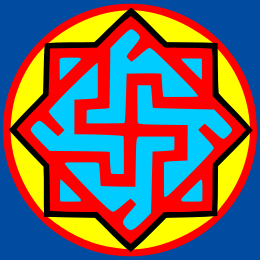

| Part of a series on |
| Slavic Native Faith |
|---|
 |
Ynglism (Russian: Инглии́зм; Ynglist runes: ![]() ),[5][β] institutionally the Ancient Russian Ynglist Church of the Orthodox Old Believers–Ynglings (Древнерусская Инглиистическая Церковь Православных Староверов–Инглингов, Drevnerusskaya Ingliisticheskaya Tserkov' Pravoslavnykh Staroverov–Inglingov), is a white nationalist branch of Slavic paganism[6] formally established in 1992 by Aleksandr Yuryevich Khinevich (b. 1961) in Omsk, Russia,[7] and legally recognised by the Russian state in 1998,[8] although the movement was already in existence in unorganised forms since the 1980s.[9] The adherents of Ynglism call themselves "Orthodox", "Old Believers", "Ynglings" or "Ynglists".
),[5][β] institutionally the Ancient Russian Ynglist Church of the Orthodox Old Believers–Ynglings (Древнерусская Инглиистическая Церковь Православных Староверов–Инглингов, Drevnerusskaya Ingliisticheskaya Tserkov' Pravoslavnykh Staroverov–Inglingov), is a white nationalist branch of Slavic paganism[6] formally established in 1992 by Aleksandr Yuryevich Khinevich (b. 1961) in Omsk, Russia,[7] and legally recognised by the Russian state in 1998,[8] although the movement was already in existence in unorganised forms since the 1980s.[9] The adherents of Ynglism call themselves "Orthodox", "Old Believers", "Ynglings" or "Ynglists".
The Ynglist Church was described by some scholars as having a complex and well-defined doctrine and liturgy, an authoritative leading hierarchy, and as focusing on esoteric teachings.[10] The Ynglists regard themselves as preserving the true, orthodox (i.e. in accordance with the universal order, right), religious tradition of the Russians, of all Slavs, and of all white European "Aryans".[11] Other Rodnover groups in Russia are strongly critical of Ynglism; at a veche of Russian Rodnover organisations Ynglist doctrines were formally rejected.[12] In the mid 2000s the church faced judicial prosecutions for ethnic hatred and Khinevich himself was convicted with probation between 2009 and 2011.[13] After the central organisation in Omsk was dissolved, the movement proliferated into multiple groups in all the regions of Russia, and also in various countries of Europe and North America.[14] The holy writings of Ynglism are the four Slavo-Aryan Vedas.[15]
- ^ a b c d e f g Cite error: The named reference
Derzhavarus-Ynglism-summarywas invoked but never defined (see the help page). - ^ Cite error: The named reference
Derzhavarus-Ynglismwas invoked but never defined (see the help page). - ^ Golovneva 2018, p. 341.
- ^ a b Cite error: The named reference
Derzhavarus-symbolswas invoked but never defined (see the help page). - ^ Saunders 2019, p. 566.
- ^ Golovneva 2018, p. 340; Saunders 2019, p. 566.
- ^ Gaidukov 2000, p. 33; Matytsin 2009, passim; Aitamurto 2016, p. 50; Skrylnikov 2016, passim.
- ^ Matytsin 2009, passim.
- ^ Matytsin 2009, passim; Golovneva 2018, p. 341.
- ^ Gaidukov 2000, pp. 33, 42, 141–142; Aitamurto 2007, passim; Aitamurto 2016, p. 51.
- ^ Aitamurto 2007, passim; Golovneva 2018, pp. 340–341.
- ^ Aitamurto 2016, p. 51; Gaidukov 2016, p. 40; Skrylnikov 2016, passim; Prokopyuk 2017, p. 45; Golovneva 2018, p. 340.
- ^ Matytsin 2009, passim; Aitamurto 2016, p. 51; Golovneva 2018, p. 341.
- ^ Matytsin 2009, passim; Maltsev 2015, passim.
- ^ Aitamurto 2016, p. 50; Yashin 2016, p. 39.
Cite error: There are <ref group=lower-greek> tags on this page, but the references will not show without a {{reflist|group=lower-greek}} template (see the help page).
